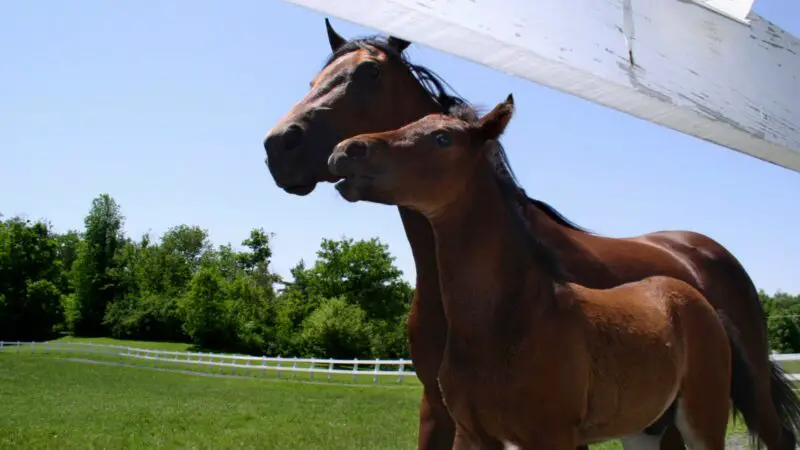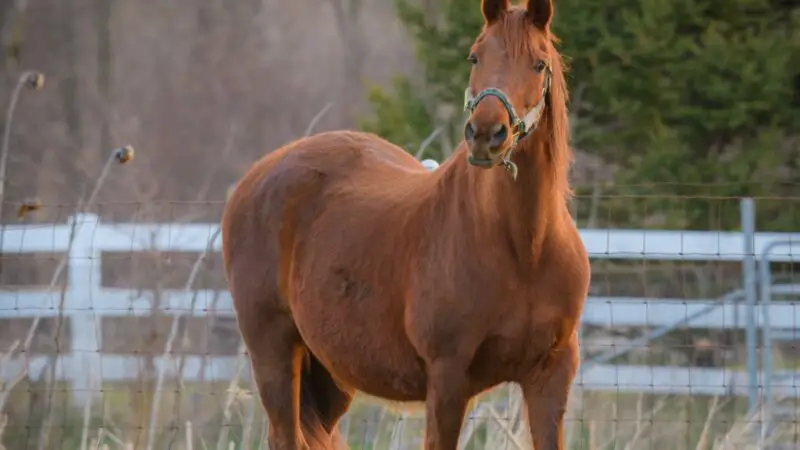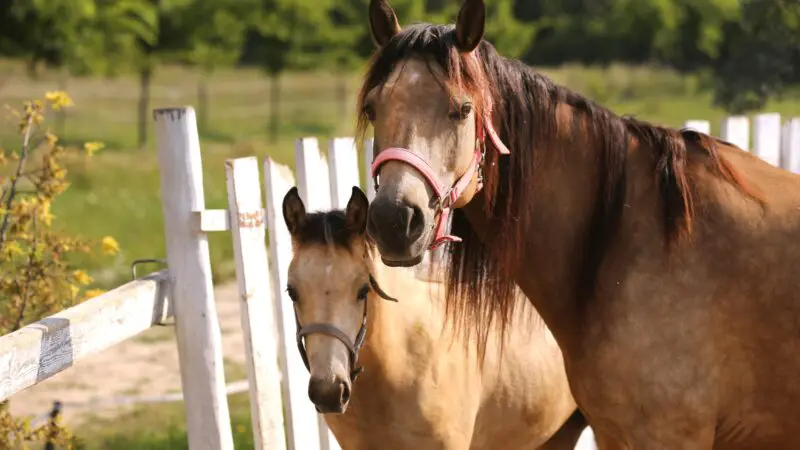Although it is an expensive endeavor, raising and owning horses can be highly exciting and rewarding. You get the benefit of recreation, companionship, and even relaxation! Before that, it is important to know which breed you should choose and what better horse is out there than the Morgan Traditional horse.
Morgan horses are a finely built, strong-legged, graceful, and versatile breed as they can be raised for a variety of purposes such as driving, pleasure riding, cutting and endurance riding, dressage, and even as exhibition horses. Morgan horses are also great for beginners due to their good disposition.
This article discusses everything you need to know about Morgan Traditional horses, their origins, appearance, distinctive characteristics, and other relevant information. Read further this article for more!
Morgan Traditional Horse History

The Morgan horse is a heritage breed created in the United States and is believed to be descended from a foundation stock called Justin Morgan, named after his owner of the same name. A DNA study conducted by the University of Guelph reported that the Morgans are closely related by genes to the Canadian horse breed.
Justin Morgan, as an adult breeding stallion, produced three sons named Bulrush, Sherman, and Woodbury, who all rose to popularity in New England. For a time, the families of the sons bred within separate bloodlines. However, over time, the families interbred, becoming what is now called the Lamberts, Lippitts, Working Western, and Government families.
As the automobile industry boomed in the country, the demand for driving horses drastically declined. The US Government introduced new horses into the bloodlines of the Morgan, creating 2 varieties: Foundation (Traditional) and Non-Foundation Morgan horses. Foundation Morgans are those with little to no Morgan blood, while the opposite is true for the latter.
Today, the Morgan Traditional horse is found across the country and is still considered the Cadillac of driving horse breeds. In 2005, there were an estimated 175,000 Morgan horses worldwide.
What Is a Morgan Traditional Horse?

What Do Morgan Traditional Horses Look Like?
Morgan Traditional horses are a relatively small breed with a refined build, strong legs, straight or slightly curving profile, large and prominent eyes, upright and well-arched neck, laid-back shoulders, well-defined withers, short back, and strongly muscled hindquarters. Morgan Traditional horses give off a graceful but strong and powerful appearance.
Morgans can come in a range of colors, with most being black, bay, and chestnut, but they can also be dun, gray, silver dapple, gray, and cream. There are also 3 pinto color patterns: the splashed white, frame overo, and sabino.
How Long Does a Morgan Traditional Horse Live?
Morgan Traditional horses live an average life expectancy of 20 to 30 years if they are well taken care of, making them one of the longest-living breeds in the entire world.
What Do Morgan Traditional Horses Eat?
The majority of their diet consists of forage (either hay or pasture grass). Horse owners provide them with grain concentrates so that their horses can reach their daily nutritional requirements. The grains could be oats, corn, soybeans, barley, beet pulp, and wheat. Molasses are also often added to these concentrates so that they are palatable to the horses.
Additionally, they may be given treats such as carrots, apples, and peppermints but are given in moderation. Some owners may even formulate their treats, usually made with brown sugar or peanut butter, grains, molasses, and vegetable oil.
How Big Do Morgan Traditional Horses Grow?
They average from 14.1 to 15.2 hands (57 to 62 inches), and some individuals may be a hand taller or shorter.
Are Morgan Traditional Horses a Heavy Breed?
Morgan Traditional horses are a heavy breed, to their height. They weigh 900 to 1,100 pounds.
What Is Morgan Traditional Horse Known For?
Morgan Traditional horses are a versatile breed as they are raised for driving, pleasure riding, dressage, cutting and endurance riding, carriage driving, and exhibition horses.
Where Do Morgan Traditional Horses Originate?
They originate in the United States, where they were created from a foundation stock named Justin Morgan.
What Are the Distinct Characteristics of a Morgan Traditional Horse?
Morgan Traditional horses are distinguished for their vigor and stamina as well as eagerness, personality, and naturally strong way of moving. Some Morgans are gaited, which means that they can perform various gaits such as the trot, pace, rack, and fox trot.
Morgan Traditional Horse Temperament
They are courageous, intelligent, loving, and have a good disposition, making them great horses for any type of horse owner, be they, beginners or experts.
How Much Does a Morgan Traditional Horse Cost?
They are a relatively expensive breed, costing around $750 to $5,000 depending on the age, sex, and quality (if they were trained and/or registered).
Tips for Taking Care of Morgan Traditional Horses
Housing
Indoor housing is essential for horses that are used or being ridden every day. Single-story barns are usually the best option since they are inexpensive and easy to maintain. Individual box stalls inside barns should be 12 feet by 12 feet for Morgan Traditional horses. The stalls may be standing, wherein the horse is tied forward using a rope or chain or open-sided.
You can also choose outdoor housing if you are trying to lower construction and labor costs. A three-sided structure or an open barn can work as long as the horses are protected from excessive temperatures and precipitation.
Fencing
Providing your horses with protection against natural predators is essential. Although they should be allowed free exercise as much as possible, they should do so within sturdy fencing. The most common types are hardwood board and wooden post, polyvinyl chloride (PVC), post and rail, electrified wire, woven wire, or a combination of two or more of them.
Nutrition
Horses need carbohydrates which are present in fresh green grasses, legumes (clover or alfalfa), hay, and grains. There are also commercially available feeds or feeds specially formulated by veterinarians that are nutritionally balanced as long as it contains the right amount of energy, protein, vitamins, and minerals.
For Morgan Traditional horses, they require 15 to 16.5 mega calories of digestible energy, 18 to 20 grams of calcium, and 13 to 14 grams of phosphorus daily. You can feed hay to your horses using a round bale feeder or a slow-feed hay net. Moreover, they also need clean, sufficient water daily. Hard-working horses will require 15 to 20 gallons of water per day.
Grooming
Grooming your horse before and after you ride them is ideal. When brushing the hair on their heads, comb in the direction where their hair grows using a rubber groom-mitt or curry comb. To remove dirt, use a soft brush or wet sponge. When brushing the body and legs, use a dandy brush. If you can, gently rub and massage their muscles.
Schedule regular shoeing or trimming to reduce the risk of foot problems occurring. Contact a professional to do this.
Health Management
Have your horses undergo a routine health exam annually. Your horse should be dewormed and vaccinated. Dental work, Coggins test, and sheath cleaning, if necessary, can also be done when visiting your local veterinarian.
Is It Expensive to Raise Morgan Traditional Horses?
It is expensive to raise Morgan Traditional horses, as the cost of the horse is already high enough. You also have to pay for maintenance costs which include healthcare, feeding and nutrition, and other related expenses.
How Much Space Does a Morgan Traditional Horse Need?

A Morgan Traditional horse would need a 12-foot by 12-foot individual stall and at least 400 square feet of dry lot space per horse. This space excludes equipment such as feeders and waterers.
Related Questions
What Breeds Make Up the Morgan Horse?
The original Morgan horse was thought to be of Thoroughbred, Arabian, Dutch, Welsh, or Friesian descent, although this has never been truly confirmed.
Are Morgan Horses Endangered?
Morgan horses are endangered, they are considered critically endangered.
Are All Morgans Gaited?
Morgans are generally not a gaited horse breed, but there are certainly individuals that are gaited.
How Fast Can a Morgan Horse Run?
They can run 20 to 30 miles per hour on average.
Are Morgan Horses Good for Beginners?
Morgan horses are good for beginners, due to their sweet, calm, and willing dispositions. They are also easy to train and are highly attentive to their owners, regardless if they are beginners or experts.
Are Morgan Horses Good Horses?
Morgan horses are good horses, they are an ideal breed for anyone.
What Are Morgan Horses Predators?
Their natural predators are large-sized animals such as bears, mountain lions, wolves, coyotes, and cougars.
Are Morgan Horses Good Jumpers?
Morgan horses are good jumpers, specifically, Morgan Traditional horses are great jumpers since they are crossed with breeds that are good at jumping.
How Much Weight Can a Morgan Horse Carry?
Since horses can carry 20% of their body weight, and Morgan horses weigh 900 to 1,100 pounds, they have a carrying capacity of about 180 to 220 pounds.
